AMD talks PC GPU ray tracing as it looks to the future of Ryzen and Radeon - saxtononsgived
AMD confirmed Thursday that its next-generation RDNA 2 graphics computer architecture will be its first to include hardware ray trace, and that it will advance public presentation-per-watt improvements by an additional 50 percent over its current designs. The accompany as wel plans to add a compute-specific version of its GPUs, dubbed "CDNA."
AMD has traditionally used its financial analyst meetings to provide insight into its future scheme in the CPU and GPU markets, especially with regard to the PC, mobile, and server spaces. It's the latter grocery store in which AMD is driving firmly, as enterprise and scientific markets are willing to salary top dollar for a high-margin Epyc processor—the sort of boon financial analysts like to hear astir.
AMD habitually offers more insight into its server roadmaps equally a way of life of construction credibility with customers, chief merchandising officer John Joseph Deems Taylor said in advance of the call. In this case, however, the company is sharing details happening key technologies that will benefit the PC besides as other segments: a new "X3D" publicity technology that bequeath complement its extant "chiplet" designs; a "CDNA" compute-intensive version of its GPUs; and RDNA 2 and 3, the evolution of the "Navi" GPU architecture that should include hardware ray tracing.
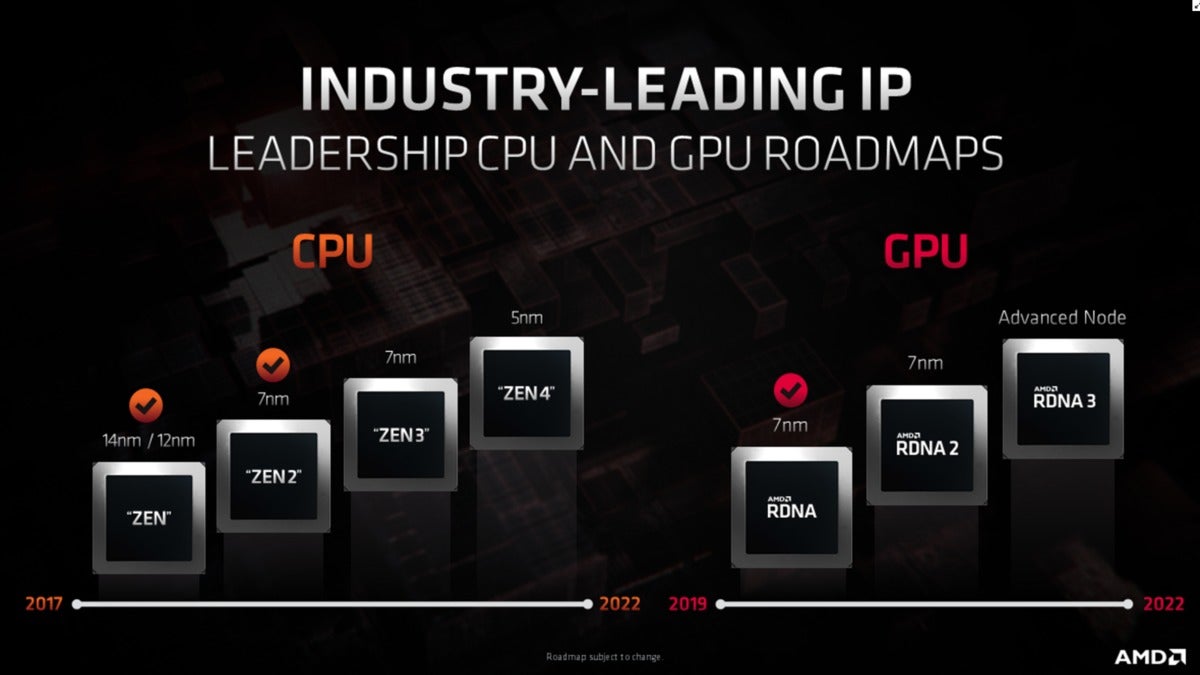 AMD
AMD AMD teased what it has advent down the pipe in price of Processor and GPU revisions. Note that AMD's non saying what the "advanced node" means.
Lisa Su, AMD's chief operating officer, began by noting that, most importantly, AMD is playing to its strengths: high functioning in graphics, CPU, and solutions that include the two. "This is the fundamental DNA of our company," she said.
AMD's Ryzen investments are gainful off
Concluded the following five days, AMD will continue to rest on its Loony toons roadmap, its RDNA architecture, and 7nm and future outgrowth technologies. AMD varied the gamy with Ryzen, and it's paid off, Su aforementioned: To the full half of agio screen background PCs use Ryzen, and it's consistently gained share over the last few quarters. AMD also continues to invest in graphics, exclusively supplying the Apple Macintosh, and shipping over 150 million units in the game console business since 2013. But, Su added, AMD is still "underrepresented" in the Personal computer market.
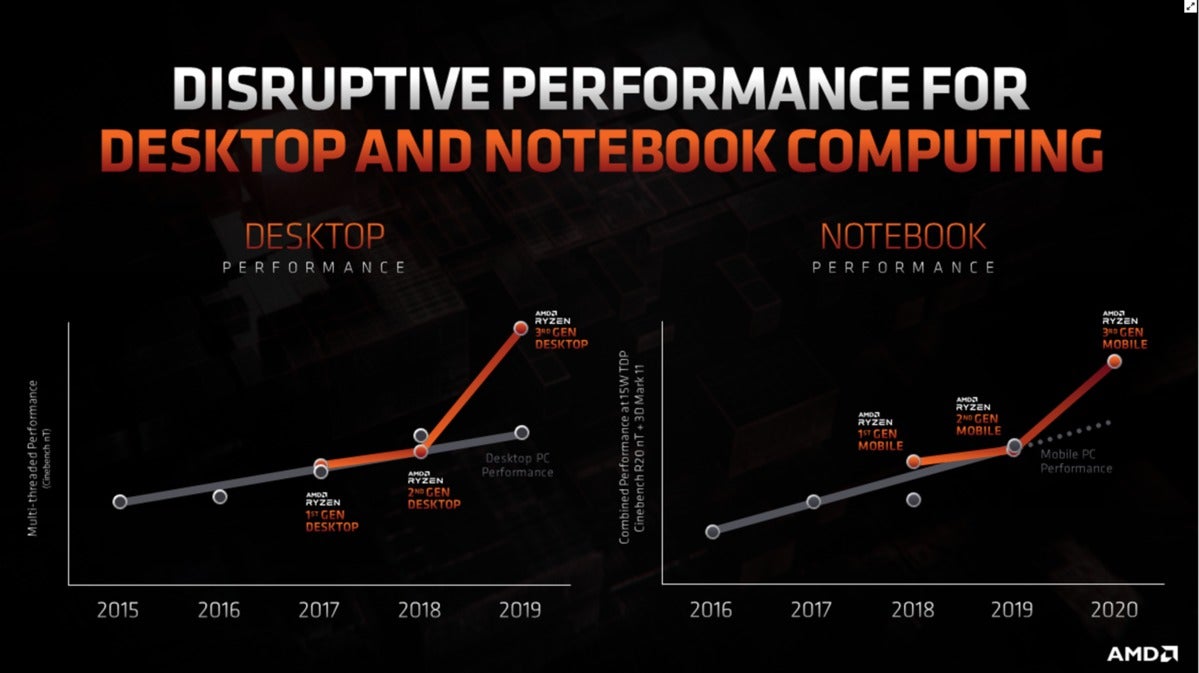 AMD
AMD AMD's execution took off with its Zen computer architecture.
Now, AMD is looking for new ways to leveraging the technology it already has in house. "We actually see much opportunities to compound our CPU and GPU solutions," Su added. AMD has used techniques such as "chiplets" to improve the flexibleness of its processor and graphics design. AMD will birth to physical body on those with new publicity and interlink techniques to keep apart pushing performance forward, Su aforementioned.
Su was so confident that the company can make it happen that AMD straight off predicts that it can deliver 20-percent compound yearbook growth in revenue terminated the next four years—aggressive numbers game for a company that was struggling just a decade ago.
What's next? Zen 4 and 5nm processors
According to Print Papermaster, AMD's chief technological officer and executive frailty president of technology and engineering, in from each one of the merchandise segments AMD serves, there's a common thread: undreamed of amounts of compute business leader.
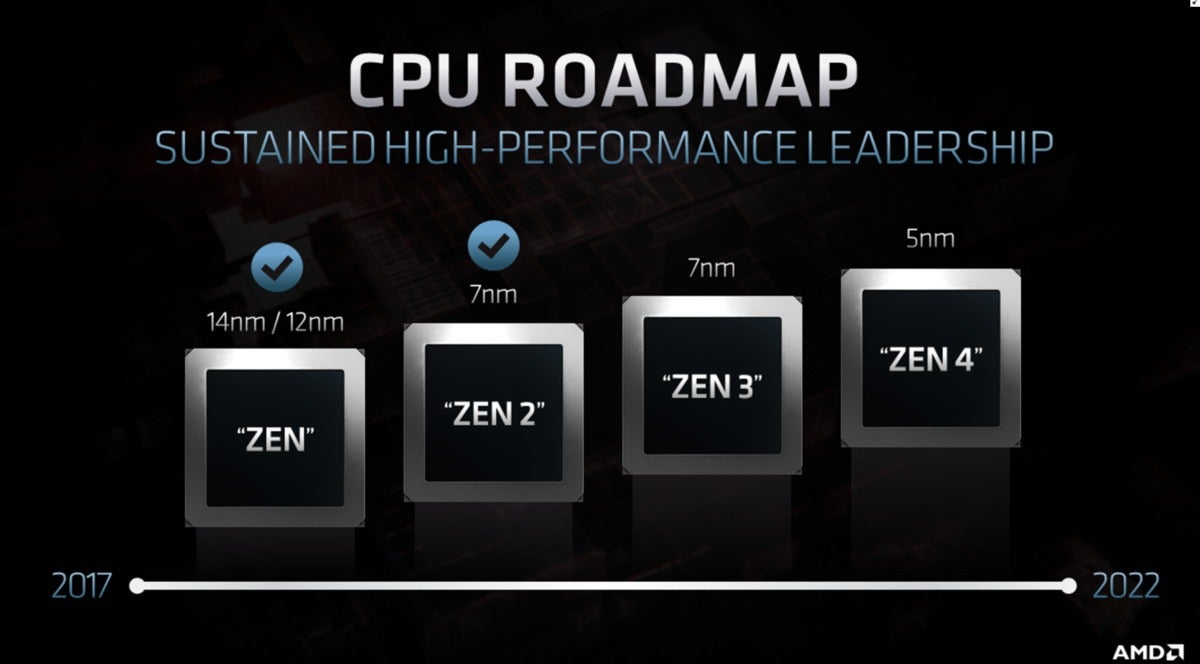 AMD
AMD AMD's Zen architecture roadmap now extends through and through 2022. Remember, this includes both Epyc products in the datacenter As well as the PC.
Papermaster noted that AMD has now switched to a "chiplet" architecture, where various products are developed as modular parts that can be fitted together. A modular go about didn't just change the design of AMD's products, it changed the accompany polish—it unnatural various teams at AMD to work in concert, Papermaster said. Likewise, it made validation simpler, allowing AMD engineers to fix whether chips were viable in hours, not days. "This is the new normal at AMD," he aforementioned.
As an deterrent example, Papermaster aforesaid that AMD developed a unmarried NUMA orbit inside its Epyc chips, organizing 7nm C.P.U. cores and connecting them with a 12nm Infinity Fabric I/O.
Papermaster aforesaid that AMD is preparation to bring "Loony toons 4" and 5nm processors into the market by 2022, without specifying which markets would constitute addressed first. (Taylor indicated that AMD's rollout strategy isn't expected to change: server eldest, and then desktop, then mobile, with all rolled out by the end of 2022.) Papermaster also said that he expects AMD's chief competitor, Intel, will solve its manufacturing problems and accelerate its manufacturing applied science.
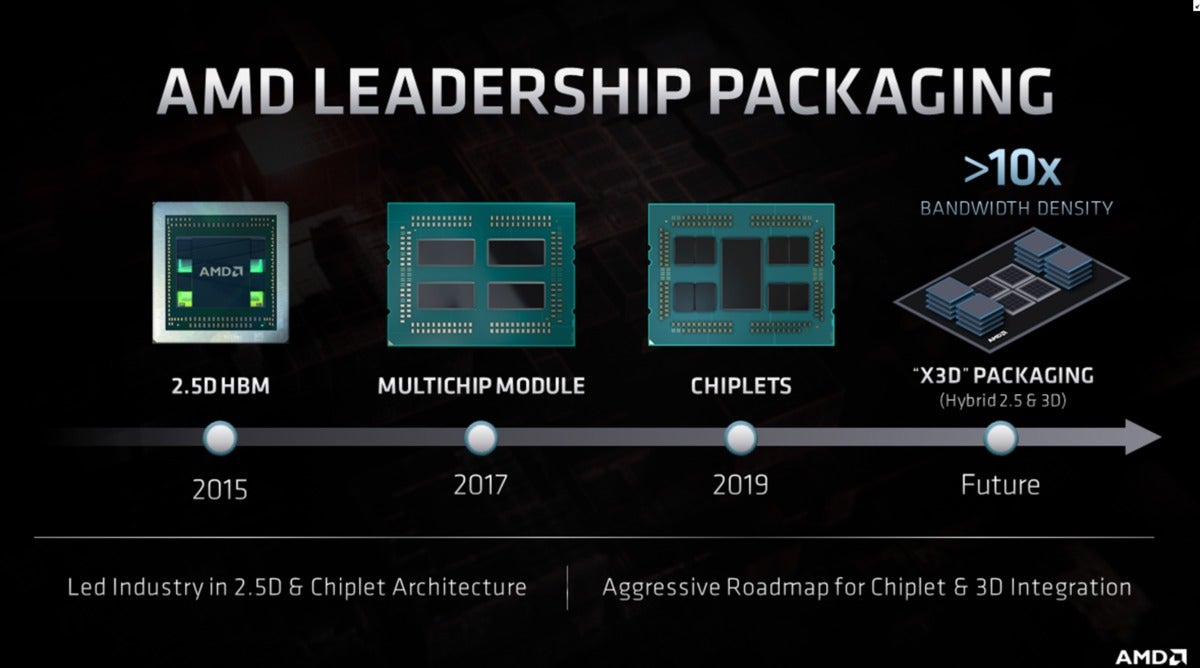 AMD
AMD AMD's X3D is an annexe of its chiplet approach, compounding stacking and a standard approach.
"Once you give birth that level athletic field, it is about how you order these solutions unitedly," Papermaster same.
The X3D packaging proficiency bequeath be accustomed combine chiplets and 3D stacking, all well-connected with its Infinity Material architecture. That Infinity Architecture testament also improve, with 3rd-gen products rolling out by 2022 with up to 8-mode GPU and coherent connectivity. "What does this mean with these types of improvements? Look at machine learning…they demand this type of connectivity," Papermaster said.
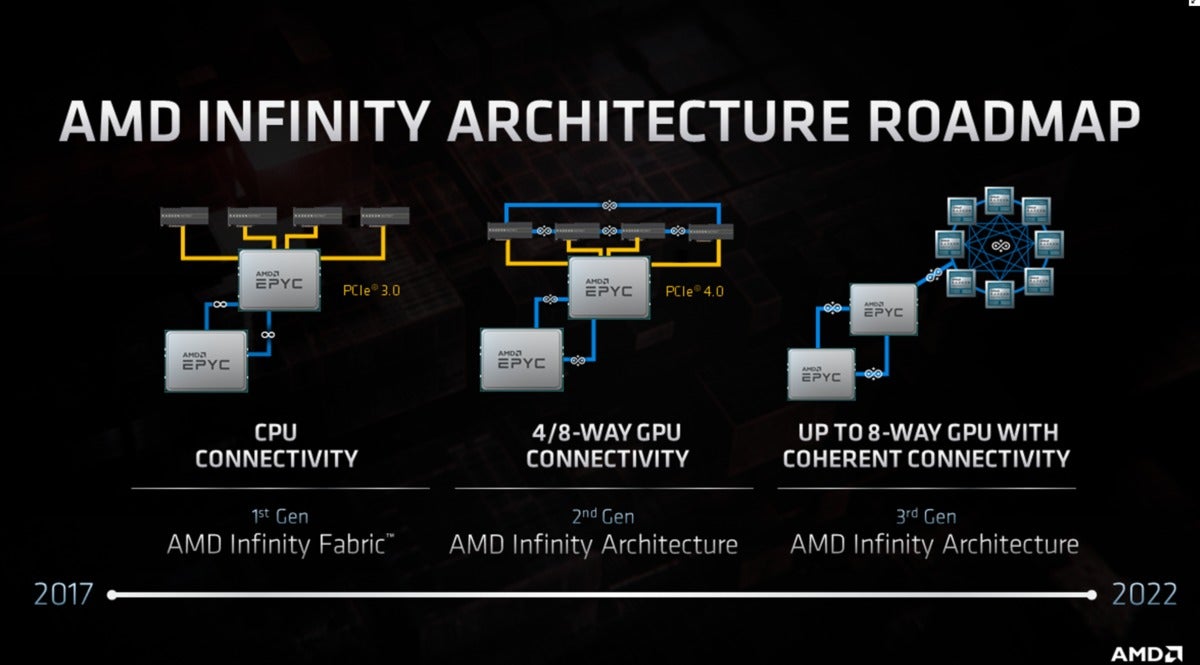 AMD
AMD AMD' Infinity Computer architecture wish probably be largely confined to servers, but not altogether.
Gigantic changes in AMD's GPU designs
Perhaps the most significant news of AMD's financial group meeting was the fact that AMD would be moving from a single GPU architecture to multiple, domain-specific architectures. Related and also significant will be the long-expected sack of computer hardware ray-tracing within the upcoming RDNA 2 GPU architecture.
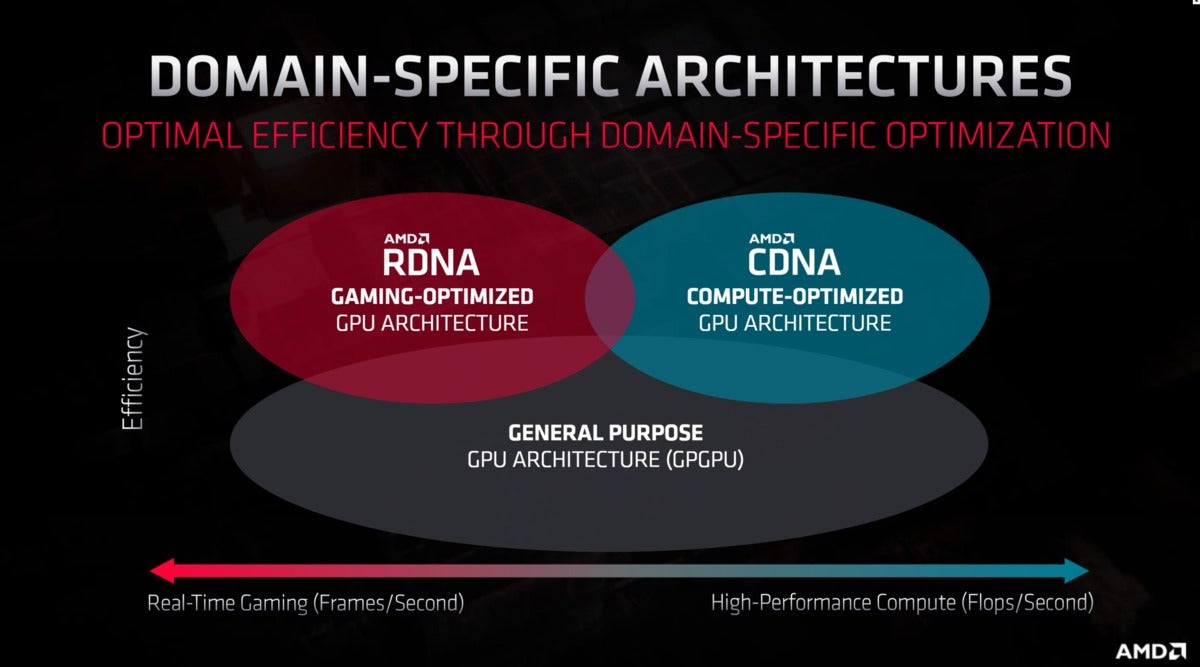 AMD
AMD AMD will be offering different versions of its GPUs for polar markets, though it's non exactly clear how profoundly they'll differ from one another.
AMD is developing specific versions of the architectures for different markets, such as the data center, because it's become increasingly difficult to develop a superior general GPU architecture as Moore's Law slows down, said David Wang, elderly vice president of the Radeon Technologies Radical at AMD.
AMD's PC GPU architecture is celebrated as RDNA, and it's been the foundation of recent Radeon cards. Before the stop of the year, however, AMD will ship RDNA 2 card game, which—hurray!—will admit hardware ray tracing, optimized both for the game consoles based upon the RDNA 2 computer architecture as well as PCs. AMD sometimes referrs to RDNA 2 as Navi 2X, with Navi 3X to follow. (The rumored "Big Navi" codename wasn't misused.) AMD already delivered a 50 percent performance-per-watt betterment with its first-generation "Navi" GPU—at once IT's aiming to be intimate again with the upcoming Navi 2X. That's crazy!
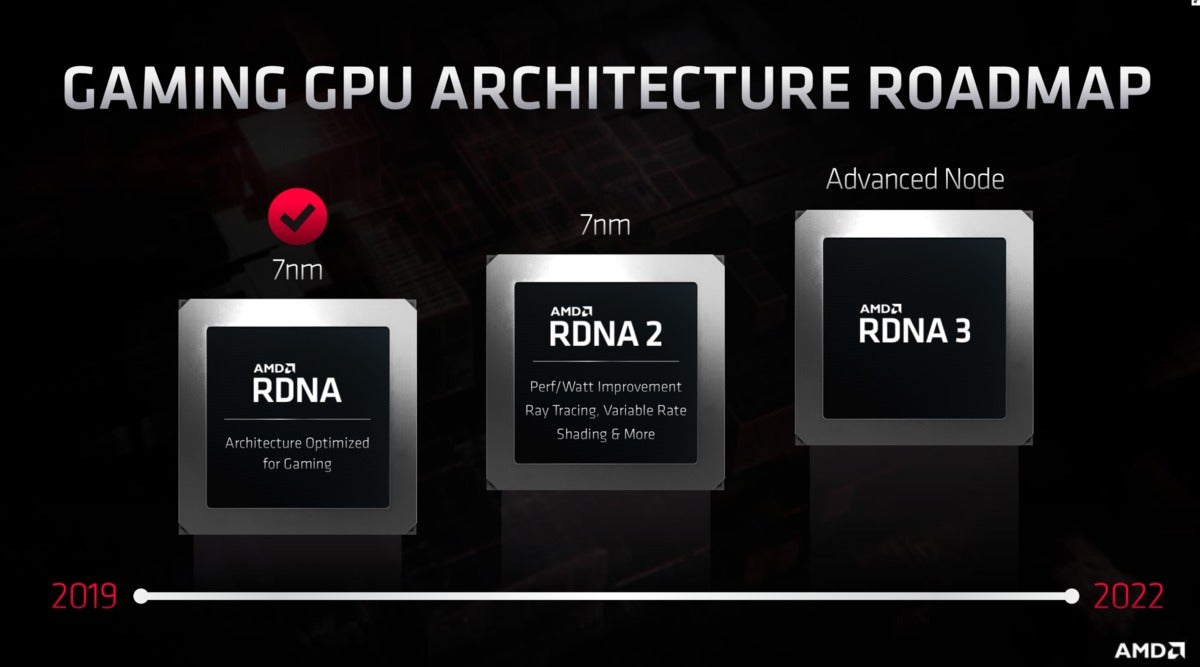 AMD
AMD AMD is at once beginning to graph its PC GPU architecture, known as RDNA, out individual years. And there's ray trace!
As for the information center, AMD's plan is to contrive a compute-specific edition of RDNA, also known as compute DNA, OR CDNA. CDNA will be scalable for multi-GPU for exascale computing and machine learning. AMD besides confirmed CDNA 2, with the 3rd-multiplication AMD Infinity Framework Architecture.
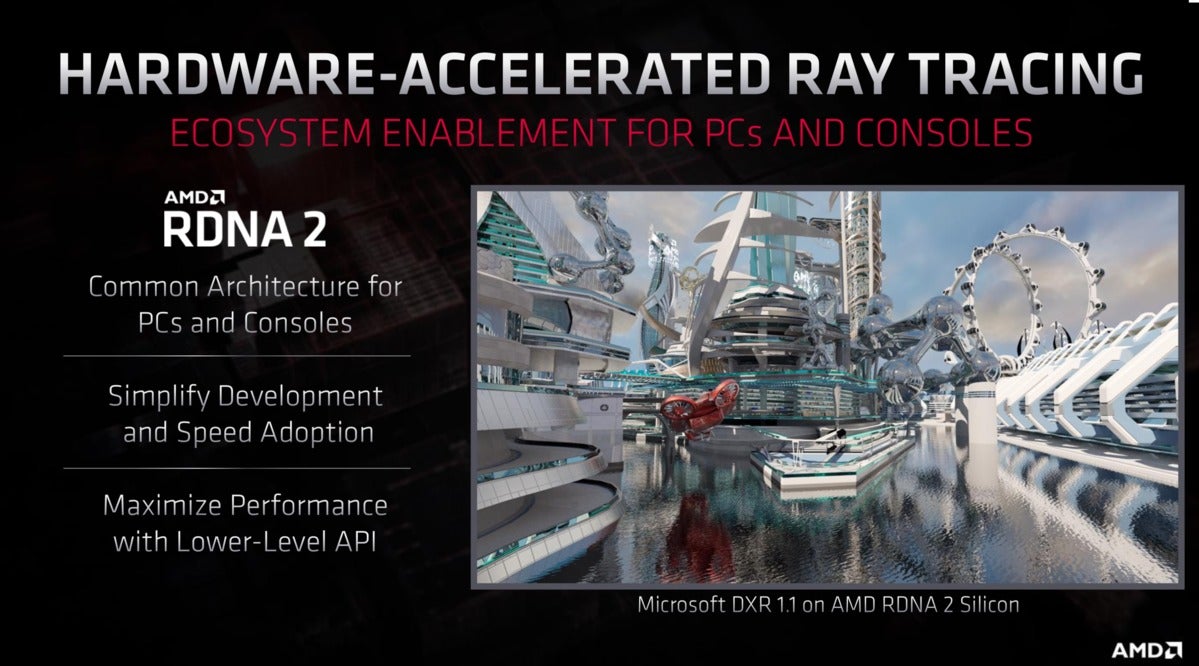 AMD
AMD Hera's what AMD is saying about hardware ray tracing.
"This is a good move Eastern Samoa datacenter GPUs don't demand galore of the features a consumer graphics card needs," aforementioned Patrick Moorhead, principal analyst at Moor Research, in an email. "[CDNA] includes elements like display and pixel rendering engines, and irradiatio trace. This way AMD can save toll aside removing those elements and add to a greater extent gates that help datacenter public presentation like tensor OPS. AMD hadn't done it until today because it couldn't afford to have two architectures. I believe AMD can field a high execution datacenter GPU, but it will need to invest at least as much in package to complete the solution."
What information technology whol means for the PC
AMD created an "execution machine" in processors, did the same with GPUs, and combined the two into an APU. Now, there's a $32 billion PC market waiting for what's next, said Rick Bergman, executive vice president of Computing and Graphics for AMD. In front the end of the year, we'll know: the fourth-coevals Ryzen processor.
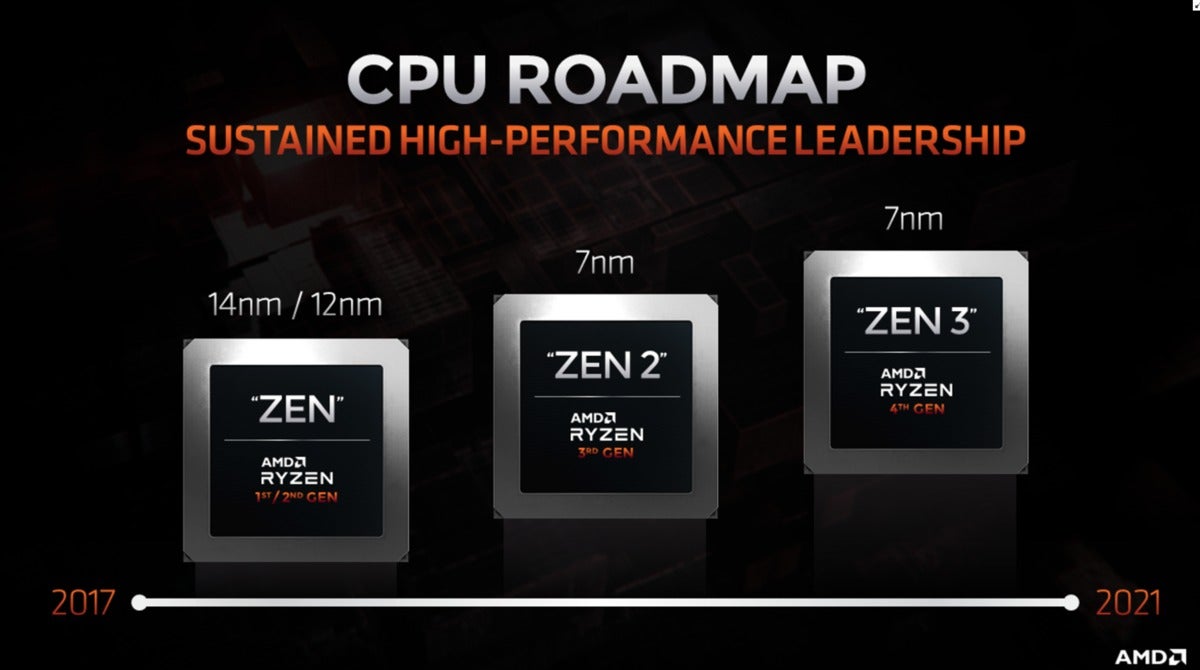 AMD
AMD AMD's Zen architecture roadmap, though 2022. Zen forms the foundation of the Ryzen processors.Note that we'll Be seeing Zen 3 chips by the end of the class.
Having locked desktop PC portion of some 17 percentage, AMD also has its centre trained on the mobile blank, with its mobile Ryzen chips aimed straightforwardly at the notebook space and specially commercial PCs. A key technology is Modern Standby, with five times the number of laptops now supporting the technology versus the prior generation, Bergman said. AMD is also claiming that versions of the 3rd-gen mobile Ryzen will fork over up to 18 hours of battery life. (That number typically varies quite a spot in the real world.)
"We want our customers to love that experience, from the clock time they open up the box to the lifetime of that experience," Ingrid Bergman same.
 AMD
AMD AMD's winning designs in GPU tally-in card game, too.
Bergman said that AMD has already latched more than 70 designs in the commercial PC space, and that's before Ryzen Mobile or the related Ryzen Mobile Pro debuted. "We're expecting a quite a little Sir Thomas More," He aforementioned.
In a surprise, Bergman showed off a slide indicating that 4th-generation Ryzen chips would get down to ship before the end of 2020, just a few months after the predicted ship date of 3rd-gen mobile Ryzen parts. (PCWorld asked for more specifics about which 4th-generation products would ship first, simply AMD did not comment further.) That's not all: AMD will transport its next the adjacent-generation RDNA 2 cards before the end of the class, "with uncompromised 4K public presentation," Bergman said. These will be the foremost cards with hardware based ray tracing and variable-range shading, atomic number 2 added.
Acknowledged, AMD is revealing light point about its Zen 2/RDNA 2 card game, its next-gen fourth-gen Ryzen processor, or anything else. Only we know they're future, and AMD will fill in the blanks atomic number 3 we get finisher.
Source: https://www.pcworld.com/article/398844/amd-talks-pc-gpu-ray-tracing-as-it-looks-to-the-future-of-ryzen-and-radeon.html
Posted by: saxtononsgived.blogspot.com


0 Response to "AMD talks PC GPU ray tracing as it looks to the future of Ryzen and Radeon - saxtononsgived"
Post a Comment